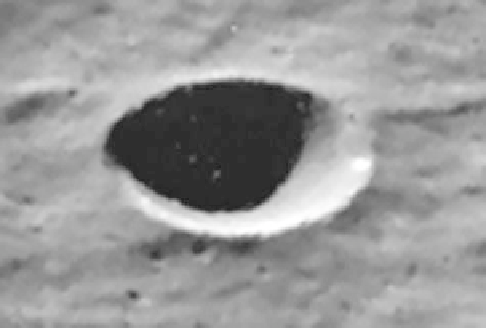Geology Reference
In-Depth Information
Figure 5.11. Complex-class craters have terraced inner walls,
scalloped rim crests, central peaks, and hummocky
floors, as seen in
the ~85 km in diameter Calvino crater in the Renoir region of
Mercury (see
Fig. 5.9
) (NASA PIA 11400).
Figure 5.9. Embayment by smooth plains into the cratered terrain to
the right and partial
flooding of the 120 km in diameter Rudaki
crater (indicated by the arrow) suggest a volcanic origin for the
plains; crater Calvino (see
Fig. 5.11
) is to the left of Rudaki (NASA PIA
11400).
Figure 5.12. An image of Raditlandi, a double-ring basin ~260 km in
diameter; the
ooded by smooth
plains of possible volcanic origin (NASA PIA 10378).
oor of this feature has been partly
Figure 5.10. An oblique view of a simple-class crater on Mercury
(~10 km in diameter), showing the typical bowl-shape and relatively
smooth rim crest (NASA Mariner 10 FDS 27475).
slumps), hummocky
floors, and central peaks (
Fig. 5.11
).
They range in size from about 10 to ~110 km in diameter
and have lower depth-to-diameter ratios than simple
craters, becoming
flatter with increasing diameter.
Double-ring basins range in size from ~110 to ~400 km
in diameter. They consist of an outer crater rim and an
inner ring, which somewhat resembles the peak-ring cra-
ters on the Moon, but the inner ring is much better de
ned
on Mercury (
Fig. 5.12
). The onset of multi-ring (three or
more rings) basins (
Fig. 5.13
) occurs at diameters of
~400 km.
craters to complex craters, double-ring basins, and multi-
ring basins. However, the transitions from one type to the
next tend to occur at smaller sizes than on the Moon.
Simple craters are bowl-shaped with smooth, circular
rim crests (
Fig. 5.10
). They are typically smaller than
~10 km in diameter and have depth-to-diameter ratios
of less than 1 to 5 (
Fig. 3.31
). Complex craters are char-
acterized by scalloped rims, terraced walls (representing






